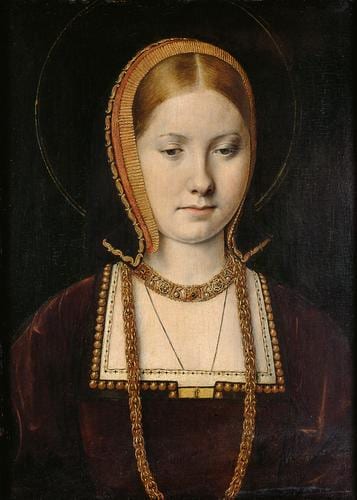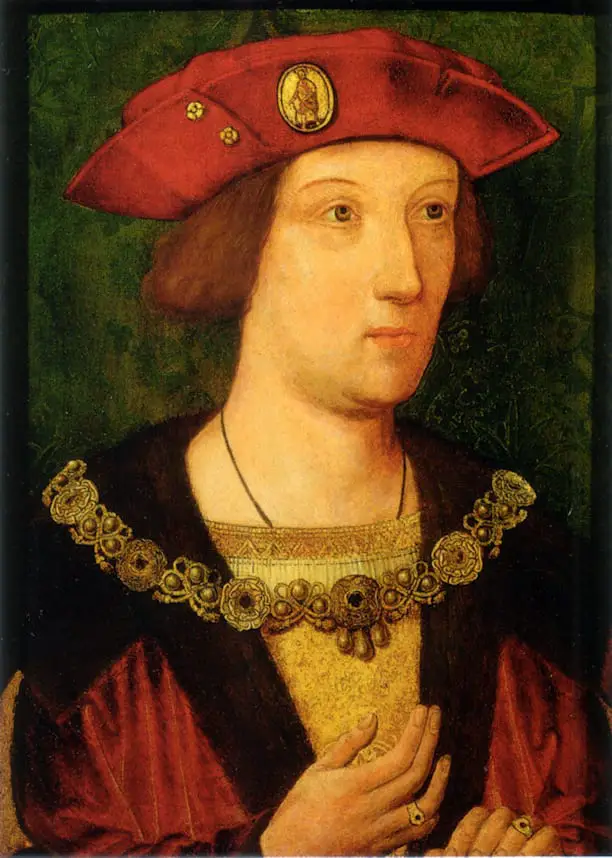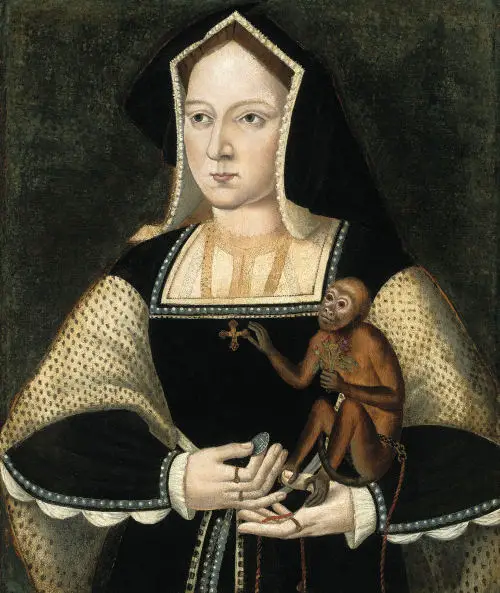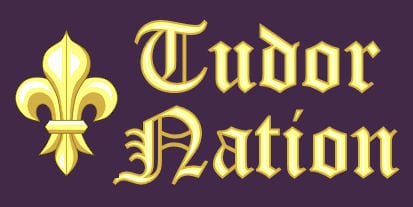Early Years
Catherine of Aragon (Catalina de Aragon) was born on 16th December 1485 at the Archbishop’s Palace in Alcala de Henares, to Ferdinand and Isabella of Spain.

She was the couple’s fifth child and was named after her great grandmother, Catherine of Lancaster. She had an older brother, Juan, who had been born in 1478 and three older sisters: Isabella who had been born in 1470, Juana who had been born in 1479 and Maria who had been born in 1481.
When Catalina was three she was dressed in a heavy brocade dress covered with jewels and paraded in front of English ambassadors who were in Spain to negotiate terms for a marriage between herself and Prince Arthur. The Treaty of Medina del Campo agreed that Catalina would marry Prince Arthur when they were both of age.
In 1497 an amendment to the Treaty agreed that Catherine would travel come to England when Arthur reached the age of 14 years. Her dowry of 200,000 crowns would be paid in three instalments, half within ten days of the marriage and the remainder paid in two equal instalments over the next two years.
Journey to England
In 1501 Catalina began her journey to England. The first stage of the journey was to travel from her home, the Alhambra in Granada, to the northern port of Corunna where she would board a boat to England. She was accompanied by a huge retinue including a household staff of 60 that would serve her in England, managed by Dona Elvira Manuel and her husband Don Pedro Manrique. She was also accompanied by her Lady in Waiting, Maria de Salinas.
On 17th August 1501 the party set sail for England. However, a violent storm in the Bay of Biscay forced the fleet to return to Spain for repairs. It was another month before the ships were ready and Catherine finally arrived in Plymouth, England on 2nd October.
Catherine, as she was now referred to, was formally welcomed by the Mayor of Plymouth and escorted to Exeter where she was to stay until an escort arrived to take her to London. Two weeks later, she began her journey to London.
On 4th November 1501 the entourage received word that King Henry VII and Prince Arthur were coming to meet Catherine informally before she reached London. Despite the protests of the Spanish Ambassador, Henry VII insisted that Catherine remove her veil. He and Arthur were relieved to see that she was pleasantly plump with grey/blue eyes and long red-gold hair.
Catherine made her formal entry into London on 12th November riding a gaily decorated horse.
Marriage to Prince Arthur
Two days later, on 14th November 1501, Catherine married Prince Arthur in St Paul’s Cathedral. The service was conducted by the Archbishop of Canterbury Henry Deane who was assisted by William Warham, Bishop of London. Arthur wore a suit of white satin while Catherine wore a white dress in the Spanish style with bell sleeves and a pleated skirt over a farthingale. She wore a headdress of white silk edged with gold and set with pearls and precious stones. The wedding celebrations included jousts, banquets, pageants, disguising and dancing and continued for two weeks.

On 21st December Catherine and Arthur left London and travelled to Ludlow in the Welsh Marches where they were to form their own court.
At the end of March 1502, both Catherine and Prince Arthur were taken ill with a viral infection. On 2nd April 1502 Prince Arthur died leaving Catherine a widow.
Abandoned in England
Ferdinand and Isabella were eager not to lose their alliance with England and were also aware that Henry VII would not want to lose Catherine’s dowry and so suggested a marriage between Catherine and Prince Henry. Negotiations began but the situation was not straightforward. Catherine’s marriage to Arthur had only lasted a short time and half her dowry remained unpaid. If the marriage had been consummated then the second half of the dowry was due to be paid. If Catherine were pregnant and the child was a boy it would be heir to the throne and Catherine’s position would be secure. If Catherine was not pregnant then a papal dispensation would be needed for the marriage If the marriage had not been consummated then the second part of the dowry did not need to be paid but a dispensation may still be required.
On 23rd June 1503 a treaty was drawn up for the marriage of Catherine to Prince Henry and two days later they were formally betrothed by the Bishop of Salisbury. However, no date was set for the wedding. Catherine was given an allowance of £100 per month for the management of her household, but she found it difficult to make ends meet. Catherine’s parents refused to pay the next instalment of her dowry until she was married. Additionally, Spain was at war with France and her parents stated they had no money to send to her and that her father-in-law should be the one to provide for her.
Health Concerns
In the summer of 1504 Catherine was taken ill with a mystery illness which kept her confined to bed for much of the summer. She was subject to fits of fever and shivering and at times it was feared she would die. It is likely that the illness was a result of the stress she was under, living in a foreign country with insufficient funds and not knowing what her fate would be. She would continue to suffer from similar bouts of illness for much of her life.
Despite ratifying the marriage treaty, Henry VII had shown no sign of arranging for her marriage to Prince Henry to go ahead. When the Spanish ambassador De Puebla spoke to Henry regarding Catherine’s situation, the English king replied that Catherine should give up some of her servants and move to court where she would need less money. In desperation, Catherine eventually sold some of her jewels and plate to raise money. She remained under a great deal of stress.
In June 1505, on his father’s orders, Prince Henry made a secret but formal protest against marriage to his brother’s widow. The protest was made in the presence of Richard Foxe, Bishop of Winchester, the Lord Privy Seal and other members of the Privy Council. The young prince stated that the treaty had been made when he was a minor and as such was null and void. Despite the protest, Henry VII did not formally break the treaty, keeping his options open. This left Catherine in a state of limbo, completely at the mercy of the English King.
In November 1505, Henry VII ordered that Catherine dismiss most of her servants, leave Durham House and join the court. While at court, Catherine spent time in the company of Prince Henry and they found they had a lot in common. When Henry discovered they had grown close he sent Catherine to live at Fulham Palace.
Marriage to King Henry VIII
On 21st April 1509, Henry VII died and was succeeded by his son King Henry VIII. In early June Henry proposed to Catherine. The couple were married on 11th June 1509 at Greenwich Palace. The service was performed by the Archbishop of Canterbury, William Warham.

After her marriage Catherine was provided with a new wardrobe, mostly designed in the English fashion. She also had access to the crown jewels to supplement her own jewellery items. Her household numbered one hundred and sixty servants, some of whom were ladies who had accompanied her from Spain to England. The rest were wives and daughters of leading nobles.
As the second King of the new Tudor dynasty, Henry VIII knew it was vital that he have children. Boys would ensure the succession, while girls were important pawns in the negotiation of foreign alliances.
Catherine of Aragon Pregnancies
In total Catherine had six pregnancies but only two resulted in live births and only one child survived to adulthood.
Catherine first became pregnant in August 1509 but was delivered of a stillborn daughter on 31st January 1510.
A second pregnancy was announced in May 1510 and on 31st December 1510 a son, Henry was born. He was christened on 6th January 1511 and given his own household. However, he died on 12th February 1511.
On 17th September 1513, Catherine was prematurely delivered of a son who died shortly after birth. Some contemporaries blamed the premature birth on her exertions having ridden north to direct the Battle of Flodden Field.
In June 1514, Catherine’s fourth pregnancy was announced, but on January 8th 1515, she was delivered of a stillborn son.
Catherine’s fifth pregnancy resulted in the birth of a daughter, Mary, on 18th February 1516.
In 1518, Catherine announced another pregnancy. She was delivered of a stillborn daughter on 10th November 1518. This was her final pregnancy.
In a period where failure to deliver a healthy child was seen as the fault of a woman, Catherine’s repeated pregnancies took a toll on both her physical and mental health. To make matters worse, Henry’s mistress, Bessie Blount, gave birth to a healthy son in the Summer of 1519. Henry immediately acknowledged the child as his own naming him Henry Fitzroy.
Cast Aside / The King’s Great Matter
By 1524 Catherine of Aragon was in her late 30s and past the age of childbearing. Additionally, Henry was beginning to have doubts about the validity of his marriage to Catherine. He felt that his lack of a male heir was God’s punishment for his having married his brother’s widow and cited a passage in Leviticus as proof of this.

Henry was also attracted to Anne Boleyn, one of Catherine’s ladies and sister of Mary Boleyn who had been Henry’s mistress in 1522. In 1526 asked her to become his mistress, but she refused stating that she would only surrender her virginity to the man she married.
By June 1527 Henry was determined to divorce Catherine and marry Anne Boleyn. He told Catherine that they must separate since their marriage was unlawful. Catherine was very upset and told Henry that she would resist any move towards divorce.
Concerned for her situation, Catherine secretly wrote to her nephew, Charles V, and asked him to put pressure on the Pope to ensure her case was tried in Rome. Meanwhile, Henry charged Thomas Wolsey with obtaining his divorce by any means. The situation became known as The King’s Great Matter.
Pressure was put on Catherine to agree to the divorce or to enter a convent. Despite being separated from her daughter, Catherine remained firm that her marriage to Arthur was not consummated and that she remained the King’s true wife. She was also determined to protect her daughter’s legitimacy which would be at risk if her marriage were deemed unlawful.
In 1528, Cardinal Campeggio arrived from Rome. Together with Thomas Wolsey, now a Cardinal, they would try the King’s marriage in court the following year.
Catherine made one appearance at the Legatine court, held at Blackfriars in 1529. After asking Henry to bear witness that she had been a virgin on their wedding night, she turned to the two legates and asked for the case to be referred to Rome. She then walked out of the court never to return. The court hearing continued but no decision was reached. When Henry received a summons to Rome by the Pope he realised another solution was needed.
Break with Rome
Henry’s solution was Thomas Cromwell and Thomas Cranmer. Cromwell suggested that as King, Henry should be able to do as he pleased in his country and that if he removed allegiance to Rome and made himself Head of the Church in England, then he would not need the Pope to grant a divorce.
Henry agreed and Cromwell began the legal process to Break with Rome.

In May 1531 Catherine refused to agree with Henry’s Supremacy of the Church and stated that she would only abide by a decision made by the Pope. Two months later she was left alone at Windsor when the court moved to Woodstock. Catherine would never see Henry again. The following month she was told to leave Windsor for a smaller property. It was the first of many moves over the next five years. Each time she was moved to a smaller and more inhospitable locations.
Visitors to Catherine were strictly controlled and she was forbidden from seeing the Spanish Ambassador, her daughter and her closest friend, Maria de Salinas.
In 1533, Catherine learned that Henry had married Anne Boleyn who was pregnant. On 13th May Thomas Cranmer, now Archbishop of Canterbury, pronounced Henry’s marriage to Catherine null and void. The birth of Henry and Anne’s daughter Elizabeth in September 1533, prompted a new Act of Succession which excluded Mary from and settled the succession on the children of Henry and Anne. The new Act required that oaths be sworn by all Henry’s subjects to uphold the new Act. Those refusing would be guilty of treason.
Final Years
Catherine, now housed in Kimbolton Castle, refused to sign the Act but was fearful of retributions for her determination to maintain legitimacy of her marriage. She refused to eat any food that had not been prepared by her closest servants.
By Autumn 1534 Catherine’s health began to deteriorate. Despite her ill health, Henry refused to allow Catherine to see the Spanish Ambassador, her daughter Mary or her friend Maria de Salinas. Within a year it was clear that Catherine was dying.
Catherine of Aragon died on 7th January 1536. At the time it was widely believed that Anne Boleyn had poisoned her, but it is now thought that she had cancer. She was buried in Peterborough Cathedral on 29th January 1536.
Published May 11 2024 @ 4:30 pm – Updated – Nov 15 2024
Harvard Reference for this page:
Heather Y Wheeler. (2024 – 2025). Catherine of Aragon 1485 – 1536 Biography Available: http://www.tudornation.com/catherine-of-aragon-1485-1536 Last accessed April 15th, 2025
